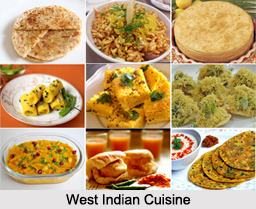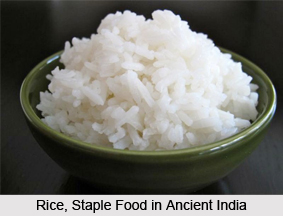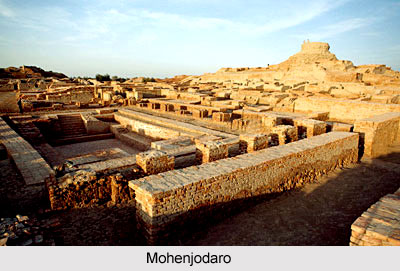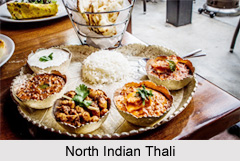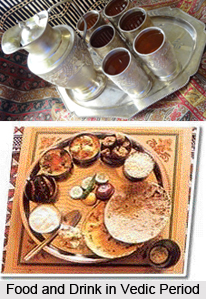 Food in Vedic period begins with cereals like rice and barley which formed a major part of food in Vedic period. The Vedic literature throws considerable light on the food and drink habits of the people of the ancient India. Among the food grains, the Rig Veda repeatedly mentions barley, particularly fried barley. These were used in preparing sweet cakes which were either dipped in ghee before eating or consumed with "Somarasa" prepared with curd and butter which formed a major part of Vedic meal. Along with this the food of the Vedic period include large varieties of pulses, dairy products, meat, salts and spices, sweets and a variety of beverages which reflect the culture of Vedic period that came through the food habits of the Indian people.
Food in Vedic period begins with cereals like rice and barley which formed a major part of food in Vedic period. The Vedic literature throws considerable light on the food and drink habits of the people of the ancient India. Among the food grains, the Rig Veda repeatedly mentions barley, particularly fried barley. These were used in preparing sweet cakes which were either dipped in ghee before eating or consumed with "Somarasa" prepared with curd and butter which formed a major part of Vedic meal. Along with this the food of the Vedic period include large varieties of pulses, dairy products, meat, salts and spices, sweets and a variety of beverages which reflect the culture of Vedic period that came through the food habits of the Indian people.
Different Food Products in Vedic Period
Food in Vedic period included both vegetarian as well as non-vegetarian food items. The agrarian culture of Indian society allowed the Vedic people to cultivate a number of pulses like masura, masa, arahar, grams, peas and kulattha along with rice, wheat and barley form a major part of food in Vedic society. Among the dairy products, milk formed the principle ingredient of the Vedic society. Generally cow"s milk was consumed after boiling it. Milk was used for preparing some more items in which milk was milked with either with soma juice or messed with grains to create a whole meal of barley. Along with cow"s milk of buffaloes was also included which has been mentioned in Rig Veda and post- Rig Veda period. Largely milk was taken in the form of fresh milk, or boiled milk or with cream. Along with various forms of milk goat milk also formed a major part of Indian society that is mentioned in the Rig Vedas.
Food in Vedic period along with these included some non vegetarian items like meat. Rig Veda mentions that whatever is offered as sacrifice including animals shall be consumed by the priest. This allows the people of Vedic age to take animal flesh as food items. Along with such food items the food of Vedic period is prepared with large variety of salts and spices such as brassica, turmeric and long pepper which are frequently mentioned in Rig Veda and other Vedic literature. Within the fruits and vegetables the Rig Vedic civilization saw distinctive use of olives and Kharitira, while mango and amlaka has been frequently referred in Vedic literature. Vegetables like cucumber and lotus stalk were used as major food items. Other food items include edible roots of the lotus and bottle gourd and saphaka which have been used as food items.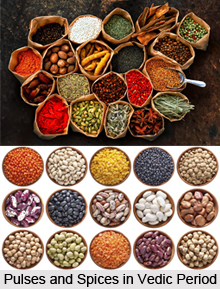
Beverages in Vedic Period
Food in Vedic period also gave special importance to beverages particularly Soma Juice which has been mentioned in all the rituals as well as all the occasions and has been treated as the most auspicious drink. The Vedic literature lays down a list of intoxicating beverages which are largely prepared by fermenting the fruit extracts. Most important among them was Soma Ras that was sweet and delicious in taste.
Cooking Methods in Vedic Period
Food in Vedic period was supposed to be cooked in some particular methods that were mentioned in Vedic literature. Mostly the people in Vedic age preferred to have completely cooked food which is supposed to be prepared after it is cleaned with sieve and are grinded. Regarding utensils the Vedic people largely used utensils made up of clay, wood and stone while other metals are also included for making other utensils. Also leather vessels were also included. Along with this the Vedic literature laid down a number of rules and etiquettes which were compulsory for a Vedic family while serving the meal.
Thus food in Vedic period mainly marked the gradual progress mankind from nomadic life which largely depended on fruits and raw food items to more sophisticate rural and semi urban life. This reflected a separate style of food habit which was now fully cooked. Since the food and kitchen belong to the inner section of the family, this reflected the inherent change in a society that can be marked different ages.
Related Articles
Indian Food
History of Indian Food
Food in Ancient India
Beverages in Vedic Period
Rig Veda
